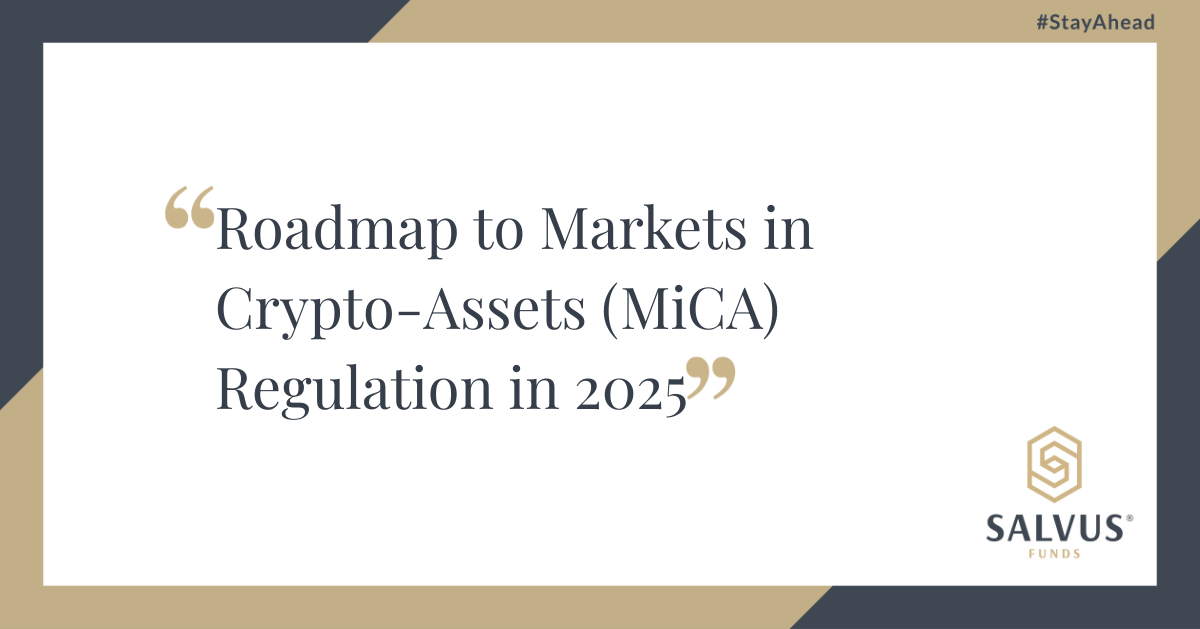Roadmap to Markets in Crypto-Assets (MiCA) Regulation in 2025
The European Union’s Markets in Crypto-Assets (MiCA) Regulation is transforming the crypto-asset landscape by introducing the first harmonised regulatory framework tailored specifically for crypto-assets not covered under existing financial services laws. With implementation deadlines approaching in June and December 2024, MiCA presents both obligations and opportunities for firms operating or planning to operate in the EU.
In this article, the SALVUS Regulatory Compliance team explains the core aspects of MiCA, the affected entities, and the key dates you should plan for — while highlighting how SALVUS and the IforPE course on MiCA can support your transition into full regulatory compliance.
1. From Fiat to Crypto – Understanding the Asset Spectrum
2. Authorisation Requirements for CASP
3. Issuance Rules and the White Paper Obligation
4. Lessons from FTX: Why MiCA Matters
5. AML alignment and the Transfer of funds Regulation (TFR)
We regularly share bite-sized insights on LinkedIn such as those found in this article
1. From Fiat to Crypto – Understanding the Asset Spectrum
MiCA begins by clearly differentiating between fiat currencies, digital assets, and crypto-assets. While fiat is issued by central banks (e.g., EUR, USD), digital assets refer more broadly to anything tokenised or transferred via Distributed Ledger Technology (DLT). Crypto-assets are a subset of digital assets and are not issued by any central authority, instead being stored and transferred via blockchain technology.
MiCA classifies crypto-assets into three distinct groups:
- Electronic Money Tokens (EMTs), such as EURC, which reference a single fiat currency.
- Asset-Referenced Tokens (ARTs), such as gold-backed tokens or currency baskets.
- Other crypto-assets, including utility tokens and cryptocurrencies like BNB or ETH.
Importantly, MiCA does not apply to security tokens, which fall under MiFID II, or to non-fungible tokens (NFTs) and CBDCs. Understanding these definitions is the first step in correctly scoping your regulatory obligations under MiCA.
2. Authorisation Requirements for CASP
One of MiCA’s most significant contributions is the introduction of a pan-European licensing regime for CASPs. Any firm offering crypto-asset services within the EU must be authorised by its National Competent Authority (NCA) — such as CySEC in Cyprus.
CASPs must be:
- EU legal persons with a registered office and effective management in an EU Member State.
- Well-governed entities with fit and proper management and sufficient internal controls.
- Able to demonstrate prudent capital levels, ranging from EUR 50,000 to EUR 150,000, depending on the services provided.
Authorised CASPs will benefit from passporting rights, allowing them to offer their services across the EU under a single licence. Physical presence is not required in host states, and cross-border notifications are managed via the home NCA and ESMA.
This framework aims to provide regulatory clarity and scalability to firms offering trading platforms, exchange services, custody solutions, and crypto-asset advice across multiple jurisdictions.
For tailored guidance or support with your MiCA compliance strategy, contact the SALVUS team, at info@salvusfunds.com.
3. Issuance Rules and the White Paper Obligation
MiCA introduces a mandatory white paper regime for the issuance or admission to trading of crypto-assets (excluding EMTs and ARTs issued by authorised institutions). The white paper must contain:
- Details about the offeror and issuer,
- Description of the crypto-asset project,
- Rights and obligations attached to the token,
- Description of the underlying technology and associated risks.
A critical element is that white papers for other crypto-assets do not require pre-approval from the NCA, but must be notified and published at least 20 working days prior to the offer. However, ARTs and EMTs require authorisation and their white papers must be approved.
The white paper must include clear disclaimers, including that the crypto-assets:
- May lose their value partially or entirely;
- May not be liquid or easily transferable;
- Are not protected under deposit guarantee or investor compensation schemes.
These requirements ensure that investors receive standardised and transparent information before participating in a crypto offering — a key advancement in retail protection across the EU.
4. Lessons from FTX: Why MiCA Matters
FTX was once one of the world’s largest cryptocurrency exchanges, offering spot trading, derivatives, custody, and margin services to a global user base. Founded in 2018 and headquartered in the Bahamas, it operated through a sprawling and opaque group structure of over 100 entities. In November 2022, FTX filed for bankruptcy following revelations of serious misconduct — including commingling of client funds, poor governance, and related-party transactions with its affiliate hedge fund, Alameda Research.
The collapse triggered a crisis of confidence in crypto markets and highlighted the systemic risks of operating without regulatory oversight. MiCA addresses these failures head-on:
- Under Article 54, CASPs must prove that senior management possesses the necessary experience, qualifications, and reputation to manage the business — a direct response to FTX’s underqualified leadership.
- CASPs must implement robust internal control frameworks and risk management systems, with clear segregation of client and proprietary assets.
- MiCA prohibits conflicted business models and mandates disclosure of adverse climate and environmental impacts, fair marketing communications, and transparent governance arrangements.
By enforcing these standards, MiCA aims to restore trust and professionalise the crypto industry, ensuring that collapses like FTX cannot occur within the EU’s regulated environment.
5. AML alignment and the Transfer of Funds Regulation (TFR)
MiCA does not operate in isolation — it is part of a broader EU strategy to regulate crypto markets, alongside the AML Regulation (EU) 2024/1624 and the Transfer of Funds Regulation (TFR).
Key takeaways include:
- CASPs are now obliged entities under the EU AML framework, subject to risk-based CDD, EDD for high-risk countries, and beneficial ownership recordkeeping.
- TFR introduces the Travel Rule, requiring CASPs to trace and disclose originator and beneficiary information for all crypto-asset transfers, including self-hosted wallets above EUR 1,000.
- The forthcoming EU AML Authority (AMLA) will supervise high-risk entities and promote consistent application of AML/CFT rules across Member States.
In Cyprus, CySEC Circular C640 integrates EBA guidelines into MiCA’s application, with sector-specific guidance on:
- Anonymity-enhancing products,
- Self-hosted wallets,
- Transaction monitoring and risk analytics.
SALVUS actively supports clients with AML policy drafting, transaction monitoring design, and AML training — ensuring end-to-end alignment with both MiCA and EU AML rules.
Conclusion
Whether you are a CASP preparing for authorisation or a project planning a token issuance, compliance with MiCA is no longer optional. The Regulation brings clarity — but also increased scrutiny — to one of the fastest-evolving financial sectors.
At SALVUS, we:
- Assist in preparing and submitting CASP applications,
- Support MiCA-compliant white paper drafting,
- Align your business model with governance and AML expectations,
- Deliver hands-on compliance training for internal teams.
To learn in-depth about these topics, we recommend the CPD-accredited IforPE course: Roadmap to Markets in Crypto-Assets (MiCA) Regulation. Taught by Nikolas Xenofontos, it combines regulatory detail with practical guidance and real-life case studies, making it a valuable resource for lawyers, compliance professionals, and founders.
For tailored guidance or support with your MiCA compliance strategy, contact the SALVUS team, at info@salvusfunds.com.
The information provided in this article is for general information purposes only. You should always seek professional advice suitable to your needs.

